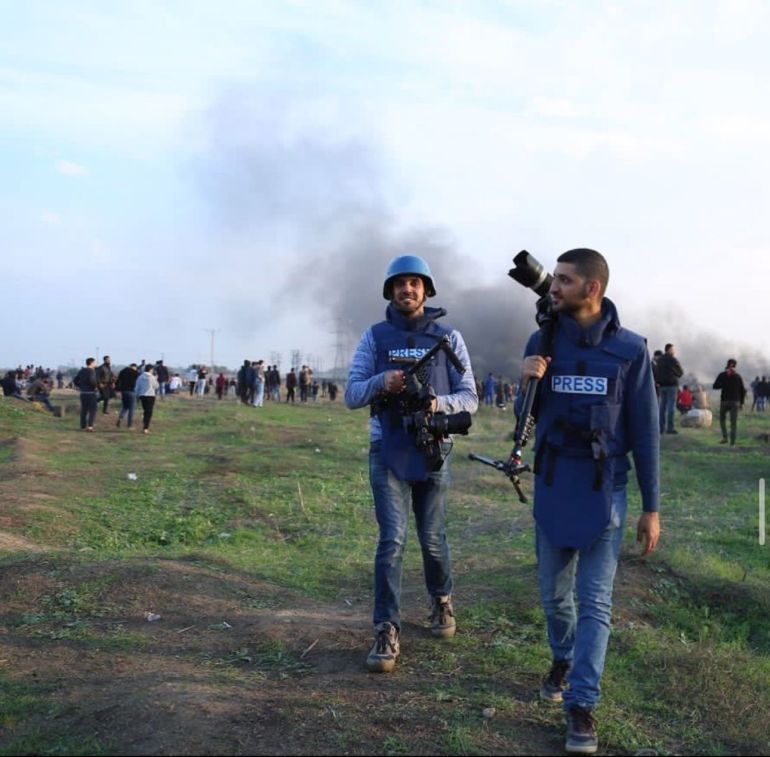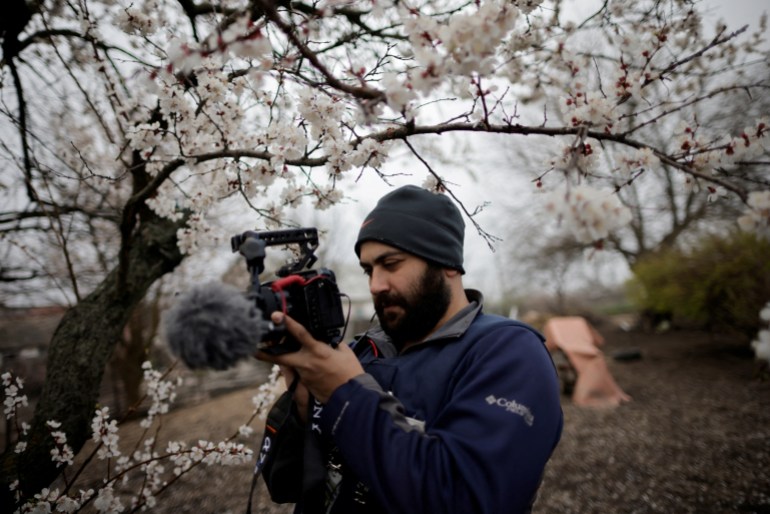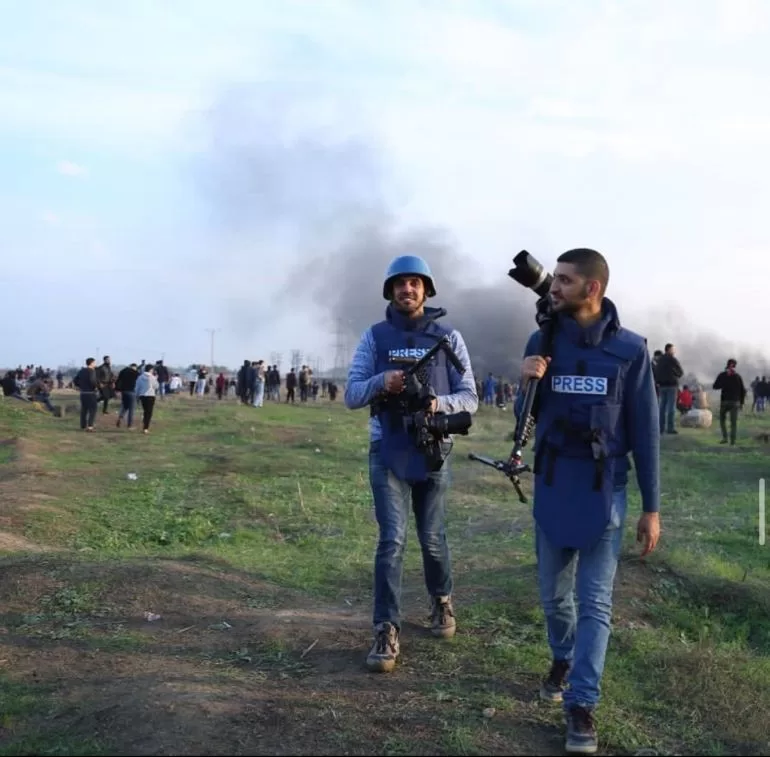Yaser Murtaja and Roshdi Sarraj were friends who shared a love of making films about life in Gaza. In 2012, they set up their own production company, Ain Media – its motto: “Deeper than you see” – with just one camera.
Little did the pair of visual poets know that their passion would cost them their lives.
Murtaja was first to be killed, targeted by a sniper while documenting the Great March of Return in 2018, a protest in which Palestinian protesters demanded they be allowed to return to the lands their families had been displaced from in 1948 with the founding of Israel. Sarraj died last year shortly after Israel launched its war on Gaza when his house was hit by two rockets. He was eating breakfast at the time, says his widow, Shrouq Aila, an investigative journalist and producer.

“He had a very severe injury in his head,” the 29-year-old Aila says. “I could see his brain inside. He survived for 20 minutes, and then he passed away.”
Ain Media is also mourning videographer Ibrahim Lafi, 21, killed under heavy shelling near the Beit Hanoon, or Erez, crossing on the Gaza-Israel border at the start of the war. Two others – Haitham Abdulwaheed, 25, and Nidal Wahidi, 33 – are currently missing.
“It’s really heavy on the heart to feel your profession is a threat,” Aila says. There is no time, she says, to grieve under the attacks.
The deaths and disappearances of the Ain Media photographers underscore the devastating ways in which visual journalists in Gaza have been hit as they work to cover the war while under fire, with limited food and water, and during power cuts and communications blackouts. More journalists have been killed in the current fighting than in any war over the past three decades. But veteran visual journalists say their peers have been particularly targeted. And while all wars are dangerous, Israel’s assault on Gaza has felt different, they say.
For the past four months, Gaza’s photographers, videographers and camera operators have acted as the eyes of the world, ensuring the civilian catastrophe unfolding in the enclave is not forgotten. With Israel mostly barring entry into the strip for foreign journalists, Gaza’s reporters have often been the only ones to offer reporting on the crisis.
The conflict has seen a new generation of talent emerge, some professionals with big name outfits, others working freelance, all potentially a click away from losing everything.
They’ve captured aerial views of rubble-strewn moonscapes and freezing tent camps; wide angle images of the people of Gaza leaving their homes behind, of countless bodies in mass graves and of crowds jostling for food with pans held aloft; mid-shots of premature babies at al-Shifa Hospital deprived of incubators, their tiny bodies squirming under fluorescent lighting; and close-ups of mothers grieving their dead children.

Names like Motaz Azaiza, the photojournalist who has come to personify the power of digital activism, have burst from nowhere as the humanity of their work moves millions. Azaiza now has more followers on Instagram than US President Joe Biden.
Occasionally, in a tragic twist, Gaza’s visual journalists have themselves become the story. Al Jazeera camera operator Samer Abudaqa, 45, was left to bleed out for five hours just a couple of kilometres away from the nearest hospital after an Israeli drone strike. According to witnesses, Israeli forces denied permission to ambulances and medical staff to reach Abudaqa, who died.
Al Jazeera’s Gaza bureau chief, Wael Dahdouh, survived that attack but in January lost his 27-year-old son, cameraman Hamza Dahdouh, in an Israeli bombing – the fifth member of his family to be killed in the latest Gaza war.

The Israeli army has told international news agencies that it cannot guarantee the safety of journalists operating in the strip. Sherif Mansour, Middle East and North Africa coordinator at the Committee to Protect Journalists (CPJ), says he sees a “deadly pattern” of assaults, detention and harassment.
‘Royal game’
As of January 20, the CPJ reported 83 journalists and media workers killed since the war began on October 7. Of these, at least 22 were photographers, videographers and camera operators.
Wielding a camera in conflicts has always been a dangerous occupation. Visual journalists are close to the action, easily identified by their equipment and at constant risk of beaming out their location. Gaza has accelerated a trend already seen in Syria, Libya and Ukraine – the people capturing vital images of conflict under fire from hostile forces.
“They were actively targeted before, but it just wasn’t as blatant as this,” says Pulitzer Prize-winning photojournalist Greg Marinovich, who spent 30 years covering conflicts around the globe and now teaches visual journalism at Boston University and the Harvard Summer School. He co-wrote The Bang Bang Club, a book recounting his experiences during South Africa’s apartheid era, which is viewed as a touchstone for photojournalists the world over.

“In South Africa, I’d say most of the killings were accidental or uncaring. Journalists were seen as royal game, but not entirely,” he says. “But this has changed radically, and part of that is the social media equation, this propaganda war that is being waged endlessly. And journalists are seen as a huge part of that. … You’ve got to understand that you are going to be targeted if you’re going to survive.”
The death of Reuters video journalist Issam Abdallah, 37, shelled by an Israeli tank crew as he filmed fire on the Israel-Lebanon border, is a case in point. He and his fellow reporters from Agence France-Presse and Al Jazeera were all wearing press flak jackets, yet were fired at not once but twice as they turned their cameras on an Israeli military outpost. AFP photographer Christina Assi, 28, was severely wounded and later had her leg amputated.

“That was definitely to stop them filming and reporting even though they were clearly marked and had been there for around an hour,” Marinovich says. “Lots of people are watching for clues, so they can spot if you’re photographing. If you report something that people don’t like, you might be standing 100 metres [110 yards] from them while they’re seeing what you’re doing. That can be a very ugly situation.”
Israeli smears
The dangers faced by Gaza’s visual journalists has been amplified by Israeli efforts to legitimise targeting them, analysts say. In November, the Israeli government alleged that several freelance photographers in Gaza who worked for major international media organisations had participated in the October 7 attacks by Hamas on southern Israel, in which nearly 1,139 people were killed and 240 taken captive. The media organisations rejected the allegations.
News shooters are driven to get as close as possible to the action, so the stakes couldn’t be higher. Aila says Ain Media’s photographers and videographers have felt safer staying in hospitals and other hubs to avoid being targeted en route to documenting casualties.
Mansour says that like other journalists, Ain Media’s workers have also faced smears. “We have identified a pattern of responses by the Israeli military to evade responsibility, calling journalists terrorists, disseminating false narratives about their association with Hamas, saying they have evidence to support that they were involved in violence. When pressed on that, they provide nothing.”
Sarraj, too, faced such accusations. An independent filmmaker, he had worked as a fixer for news organisations like Radio France and Le Monde, had taken photos for the United Nations Relief and Works Agency for Palestine Refugees and had documented human rights abuses for rights group Amnesty International.
“We were happy that international organisations refuted those claims and stood by the work that those freelancers had given,” Mansour says. “These smear campaigns have basically put people who are already in a very vulnerable and dangerous environment into imminent harm.”
In other conflict zones, you can always get out, he says. “Gaza is a 20-mile (32km) strip that’s six miles (10km) wide.
“They have no safe haven and no exit.”
